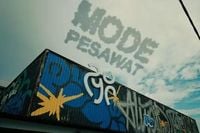In the vibrant and ever-evolving world of social media, two new trends have emerged that are capturing the attention of users in Indonesia: the absurd humor of "Italian Brainrot" and the catchy dance craze surrounding the slang term "stecu." These phenomena, both gaining traction in early 2025, reflect the creativity and playful spirit of the younger generation navigating the digital landscape.
The "Italian Brainrot" trend has taken social media platforms like TikTok and Instagram by storm, introducing a series of bizarre character names that blend absurdity with humor. This trend, which parodies traditional Italian character naming conventions, has been popularized by content creators such as Hendra Agustiawan. His viral video featuring the character "Scimpanzini Bananini"—a banana-throwing chimpanzee—sparked a wave of creativity among users, inspiring them to invent their own characters with equally whimsical names.
According to Ntvnews.id, the essence of Italian Brainrot lies in its combination of wild ideas and unexpected humor. Characters like "Crocodilo Bombardilo," a winged crocodile acting as a bomber, and "Panzerina Delfina," a dolphin-shaped tank capable of diving and firing mortars, exemplify the trend's absurdity. The use of AI-generated Italian accents via text-to-speech adds an extra layer of humor, making the characters even more entertaining.
In Indonesia, the local adaptation of this trend is known as "Anomali," which features characters like "Tung Tung Tung Sahur," a mystical drum that invades dreams, particularly during the pre-dawn meal period known as sahur. This blend of local culture with science fiction concepts has made Anomali a hit among young audiences. Other notable characters include "Bombombini Gusini," an energetic bee dropping mini-bombs, and "Bambino Nucleare," a baby with nuclear energy whose cries can devastate cities.
As these characters continue to gain popularity, they not only serve as a source of entertainment but also as a reflection of the absurdity and creativity that thrive in the digital age. The trend has sparked discussions about the nature of humor in the age of social media, as users embrace the ridiculous and the nonsensical.
Meanwhile, another trend is sweeping across social media platforms: the slang term "stecu." This term has gained traction thanks to a viral dance challenge initiated by young artist Anggit WP, who showcased the dance on TikTok and Instagram. The infectious rhythm and simple choreography of the "stecu" dance quickly captured the attention of netizens, leading to its rapid spread.
The word "stecu" is derived from a song of the same name by singer Faris Adam. The song tells the story of a man enamored with a girl who exhibits a "cool" attitude, characterized by indifference and aloofness. In this context, "stecu" is an acronym for "setelan cuek" or "stelan cuek," which translates to a nonchalant demeanor. This concept resonates with many young people, as it encapsulates the complexities of modern relationships where attraction often intertwines with a sense of detachment.
As noted by Portal Pantura, the rise of the term "stecu" is emblematic of the broader phenomenon of slang in the digital age. Young people frequently create new vocabulary as a means of self-expression and group identity. The popularity of "stecu" showcases how quickly language can evolve in response to cultural trends, especially when propelled by social media platforms that facilitate widespread sharing.
The dance challenge associated with "stecu" not only serves as a form of entertainment but also fosters a sense of community among participants. Users from diverse backgrounds come together to engage with the trend, demonstrating how social media can bridge geographical and generational gaps. The challenge encourages creativity and collaboration, as users put their unique spin on the dance and share it with their followers.
Both the "Italian Brainrot" and "stecu" trends highlight the dynamic nature of youth culture in Indonesia. They reflect how social media serves as a canvas for creativity, allowing individuals to express themselves through humor, dance, and language. As trends continue to evolve, they will undoubtedly shape the cultural landscape, influencing how young people communicate and connect with one another.
In conclusion, the emergence of these trends illustrates the power of social media to create shared experiences and foster innovation. Whether through the absurdity of Italian Brainrot or the catchy rhythms of the stecu dance, young Indonesians are redefining entertainment and expression in the digital age.






